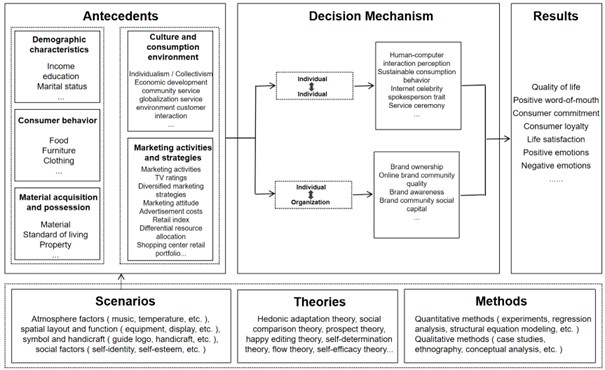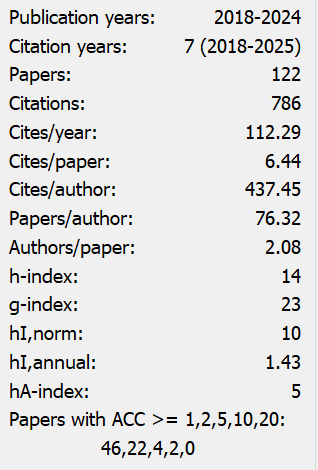The Integrated Framework and Future Prospects of Consumer Well-Being Research——Based on TCCM Framework and ADO Framework
Abstract
In recent years, transformative consumer research ( TCR ) has advocated the shift of consumer behavior to truly serve consumers, making the application value of consumer well-being increasingly reflected, which has become the frontier and focus of theoretical and practical exploration. By integrating the TCCM framework and ADO framework, this paper systematically reviews the related research on consumer well-being, constructs an integrated framework of consumer well-being research from the aspects of antecedents-decision mechanism-result-theory-situation-method, summarizes and analyzes the related constructs, antecedents and effects, influence mechanism, theoretical basis, research methods and research scenarios of consumer well-being in the existing research, and deeply analyzes the internal mechanism of consumer well-being. On this basis, this paper combines relevant theories to refine and identify the future research prospects of consumer well-being, in order to provide useful reference for the theoretical exploration and practice of consumer well-being.
References
[2] Fan, X., Chen, X., & Ruan, Y. (2023). Consumer well-being: Theoretical framework and future prospects. Journal of Marketing Science, 3(01), 78-97.
[3] Li, B., Feng, K., Jin, L., et al. (2024). Experience advantage in consumer decision-making behavior: Mechanism and prospect. Applied Psychology, 1-17. https://doi.org/10.1109/ap.2024.10.29
[4] Rahtz, D. R., & Sirgy, M. J. (2000). Marketing of health care within a community: A quality-of-life/needs assessment model and method. Journal of Business Research, 48(3), 165-176.
[5] Grzeskowiak, S., & Sirgy, M. J. (2007). Consumer well-being (CWB): The effects of self-image congruence, brand-community belongingness, brand loyalty, and consumption recency. Applied Research in Quality of Life, 2, 289-304.
[6] Paul, J., Lim, W. M., O’Cass, A., et al. (2021). Scientific procedures and rationales for systematic literature reviews (SPAR‐4‐SLR). International Journal of Consumer Studies, 45(4), O1-O16.
[7] Paul, J., & Benito, G. R. G. (2018). A review of research on outward foreign direct investment from emerging countries, including China: What do we know, how do we know and where should we be heading? Asia Pacific Business Review, 24(1), 90-115.
[8] Paul, J., & Rosado-Serrano, A. (2019). Gradual internationalization vs born-global/international new venture models: A review and research agenda. International Marketing Review, 36(6), 830-858.
[9] Ryan, R. M., & Deci, E. L. (2001). On happiness and human potentials: A review of research on hedonic and eudaimonic well-being. Annual Review of Psychology, 52(1), 141-166.
[10] Desmeules, R. (2002). The impact of variety on consumer happiness: Marketing and the tyranny of freedom. Academy of Marketing Science Review, 12(1), 1-18.
[11] Sirgy, M. J., Lee, D. J., & Bae, J. (2006). Developing a measure of internet well-being: Nomological (predictive) validation. Social Indicators Research, 78, 205-249.
[12] Zhong, J. Y., & Mitchell, V. W. (2010). A mechanism model of the effect of hedonic product consumption on well-being. Journal of Consumer Psychology, 20(2), 152-162.
[13] Huang, S. (2019). Research on the impact of customer participation on consumer happiness (Master's thesis). Zhongnan University of Economics and Law.
[14] Biswas-Diener, R., & Diener, E. (2001). Making the best of a bad situation: Satisfaction in the slums of Calcutta. Social Indicators Research, 55, 329-352.
[15] Kraut, R., Patterson, M., Lundmark, V., et al. (1998). Internet paradox: A social technology that reduces social involvement and psychological well-being? American Psychologist, 53(9), 1017.
[16] Lee, D. J., Sirgy, M. J., Larsen, V., et al. (2002). Developing a subjective measure of consumer well-being. Journal of Macromarketing, 22(2), 158-169.
[17] Sirgy, M. J., Lee, D. J., Kosenko, R., et al. (1998). Does television viewership play a role in the perception of quality of life? Journal of Advertising, 27(1), 125-142.
[18] Oishi, S., Diener, E., Lucas, R. E., et al. (2009). Cross-cultural variations in predictors of life satisfaction: Perspectives from needs and values. Culture and Well-being: The Collected Works of Ed Diener, 109-127.
[19] Inglehart, R. (2000). Genes, culture, democracy, and happiness. Culture and Subjective Well-Being/The MIT Press.
[20] Zhang, Y., Ma, Q., & Yang, Y. (2017). Research on the development and driving factors of consumer well-being construct based on service consumption situation. Journal of Management, 14(04), 568-579.
[21] Shen, P., Wan, D., Li, J., et al. (2023). Research on the dual-path influence mechanism of online brand community quality on brand well-being. Management Review, 35(08), 184-197.
[22] Shen, P., Wan, D., Li, J., et al. (2023). Research on the dual-path influence mechanism of online brand community quality on brand well-being. Management Review, 35(08), 184-197.
[23] Huang, J., & Zhong, J. (2023). Analysis of the relationship between online retail, brand awareness and consumer well-being. Business Economics Research, (06), 56-59.
[24] El Hedhli, K., Chebat, J. C., & Sirgy, M. J. (2013). Shopping well-being at the mall: Construct, antecedents, and consequences. Journal of Business Research, 66(7), 856-863.
[25] Zhong, J. Y., & Mitchell, V. W. (2010). A mechanism model of the effect of hedonic product consumption on well-being. Journal of Consumer Psychology, 20(2), 152-162.
[26] Diener, E., & Suh, E. (1997). Measuring quality of life: Economic, social, and subjective indicators. Social Indicators Research, 40, 189-216.
[27] Zhang, J., Xu, F., Sun, Y., et al. (2010). Happiness and its promotion strategies from the perspective of behavioral decision-making. Psychological Science Progress, 18(07), 1096-1103.
[28] Mei, X., & Wang, Y. (2023). Fuzzy DEA cross-efficiency evaluation method based on prospect theory. Operation and Management, 32(05), 161-167.
[29] Kotler, P. (1973). Atmospheric as a marketing tool. Journal of Retailing, 49(4), 48-64.
[30] Bitner, M. J. (1992). Servicescapes: The impact of physical surroundings on customers and employees. Journal of Marketing, 56(2), 57-71.
[31] Baker, J., Parasuraman, A., Grewal, D., et al. (2002). The influence of multiple store environment cues on perceived merchandise value and patronage intentions. Journal of Marketing, 66(2), 120-141.
[32] Mogilner, C., Aaker, J., & Kamvar, S. D. (2012). How happiness affects choice. Journal of Consumer Research, 39(2), 429-443.
[33] Yu, Y., & Fengjie, J. (2016). The development and application of hedonic adaptation theory. Advances in Psychological Science, 24(10), 1663-1669.
[34] Li, F. (2021). Happiness marketing: A new management framework. Journal of Beijing Technology and Business University (Social Science Edition), 36(01), 1-13.


This work is licensed under a Creative Commons Attribution 4.0 International License.
Copyright for this article is retained by the author(s), with first publication rights granted to the journal.
This is an open-access article distributed under the terms and conditions of the Creative Commons Attribution license (http://creativecommons.org/licenses/by/4.0/).


























